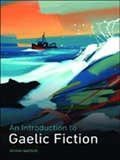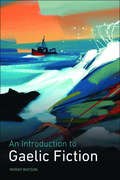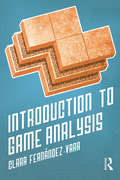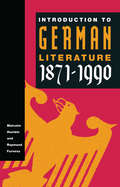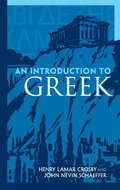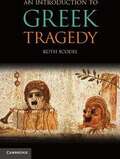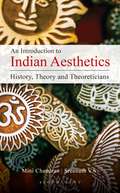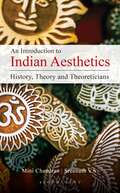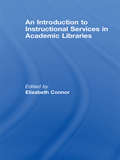- Table View
- List View
An Introduction to Gaelic Fiction
by Moray WatsonThis is the first book to provide a thorough introduction to Gaelic fiction. It traces the evolution of the form over the last century and focuses on the major developments that have led to the recent flourishing in Gaelic fiction publishing. The book follows a broadly chronological structure. The early chapters examine the emergence of fiction at the beginning of the last century, and discuss the cultural context. This leads into a broad exploration of the various kinds of fiction that have been written throughout the century. All of the novels and novellas are examined in turn, from Dùn-Aluinn to Dìleas Donn and Shrapnel, and the book also deals with all the short story collections and a large bulk of the uncollected fiction. As well as covering the work of well-known authors like Iain Moireach, Tormod Caimbeul and Iain Mac a' Ghobhainn, the book has space for many of the lesser-known names that have appeared in magazines such as Gairm. The final chapters focus on the current state of scholarship and criticism of Gaelic fiction and discuss the most recent and remarkable initiatives that have more than sustained the viability of fiction in the Gaelic language. Key Features * The only introduction to Gaelic fiction available * Analyses all novels and novellas, all short story collections, and much of the uncollected fiction * Places Gaelic fiction within a wider context * Examines the critical approaches taken to the fiction so far and introduces research areas that must be explored
An Introduction to Gaelic Fiction
by Moray WatsonThe first book to provide a thorough introduction to Gaelic fiction. It traces the evolution of the form over the last century and focuses on the major developments that have led to the recent flourishing in Gaelic fiction publishing.
Introduction to Game Analysis
by Clara Fernández-VaraGame analysis allows us to understand games better, providing insight into the player-game relationship, the construction of the game, and its sociocultural relevance. As the field of game studies grows, videogame writing is evolving from the mere evaluation of gameplay, graphics, sound, and replayablity, to more reflective writing that manages to convey the complexity of a game and the way it is played in a cultural context. Introduction to Game Analysis serves as an accessible guide to analyzing games using strategies borrowed from textual analysis. Clara Fernández-Vara’s concise primer provides instruction on the basic building blocks of game analysis—examination of context, content and reception, and formal qualities—as well as the vocabulary necessary for talking about videogames' distinguishing characteristics. Examples are drawn from a range of games, both digital and non-digital—from Bioshock and World of Warcraft to Monopoly—and the book provides a variety of exercises and sample analyses, as well as a comprehensive ludography and glossary.
Introduction to Game Analysis
by Clara Fernández-VaraGame analysis allows us to understand games better, providing insight into the player-game relationship, the construction of the game, and its sociocultural relevance. As the field of game studies grows, videogame writing is evolving from the mere evaluation of gameplay, graphics, sound, and replayablity, to more reflective writing that manages to convey the complexity of a game and the way it is played in a cultural context. Introduction to Game Analysis serves as an accessible guide to analyzing games using strategies borrowed from textual analysis. Clara Fernández-Vara’s concise primer provides instruction on the basic building blocks of game analysis—examination of context, content and reception, and formal qualities—as well as the vocabulary necessary for talking about videogames' distinguishing characteristics. Examples are drawn from a range of games, both digital and non-digital—from Bioshock and World of Warcraft to Monopoly—and the book provides a variety of exercises and sample analyses, as well as a comprehensive ludography and glossary.
An Introduction to Game Studies
by Frans MayraAn Introduction to Game Studies is the first introductory textbook for students of game studies. It provides a conceptual overview of the cultural, social and economic significance of computer and video games and traces the history of game culture and the emergence of game studies as a field of research. Key concepts and theories are illustrated with discussion of games taken from different historical phases of game culture. Progressing from the simple, yet engaging gameplay of Pong and text-based adventure games to the complex virtual worlds of contemporary online games, the book guides students towards analytical appreciation and critical engagement with gaming and game studies. Students will learn to: - Understand and analyse different aspects of phenomena we recognise as 'game' and play' - Identify the key developments in digital game design through discussion of action in games of the 1970s, fiction and adventure in games of the 1980s, three-dimensionality in games of the 1990s, and social aspects of gameplay in contemporary online games - Understand games as dynamic systems of meaning-making - Interpret the context of games as 'culture' and subculture - Analyse the relationship between technology and interactivity and between 'game' and 'reality' - Situate games within the context of digital culture and the information society With further reading suggestions, images, exercises, online resources and a whole chapter devoted to preparing students to do their own game studies project, An Introduction to Game Studies is the complete toolkit for all students pursuing the study of games. The companion website at www.sagepub.co.uk/mayra contains slides and assignments that are suitable for self-study as well as for classroom use. Students will also benefit from online resources at www.gamestudiesbook.net, which will be regularly blogged and updated by the author. Professor Frans Mäyrä is a Professor of Games Studies and Digital Culture at the Hypermedia Laboratory in the University of Tampere, Finland.
An Introduction to Game Studies (PDF)
by Frans MayraAn Introduction to Game Studies is the first introductory textbook for students of game studies. It provides a conceptual overview of the cultural, social and economic significance of computer and video games and traces the history of game culture and the emergence of game studies as a field of research. Key concepts and theories are illustrated with discussion of games taken from different historical phases of game culture. Progressing from the simple, yet engaging gameplay of Pong and text-based adventure games to the complex virtual worlds of contemporary online games, the book guides students towards analytical appreciation and critical engagement with gaming and game studies. Students will learn to: - Understand and analyse different aspects of phenomena we recognise as 'game' and play' - Identify the key developments in digital game design through discussion of action in games of the 1970s, fiction and adventure in games of the 1980s, three-dimensionality in games of the 1990s, and social aspects of gameplay in contemporary online games - Understand games as dynamic systems of meaning-making - Interpret the context of games as 'culture' and subculture - Analyse the relationship between technology and interactivity and between 'game' and 'reality' - Situate games within the context of digital culture and the information society With further reading suggestions, images, exercises, online resources and a whole chapter devoted to preparing students to do their own game studies project, An Introduction to Game Studies is the complete toolkit for all students pursuing the study of games. The companion website at www.sagepub.co.uk/mayra contains slides and assignments that are suitable for self-study as well as for classroom use. Students will also benefit from online resources at www.gamestudiesbook.net, which will be regularly blogged and updated by the author. Professor Frans Mäyrä is a Professor of Games Studies and Digital Culture at the Hypermedia Laboratory in the University of Tampere, Finland.
An Introduction to German Literature, 1871-1990
by Raymond Furness Malcolm HumbleThe book is an invaluable guide to the literature of the German-speaking countries of the last one hundred and twenty years. It takes as its starting point the Grnderzeit and its prevailing ethos; it traces the breakthrough of die Moderne (Naturalism), the attitudes of fin de sicle aestheticism, the eruption of expressionism, the literature of the Weimar Republic, of Nazism and exile. The post-1945 division is discussed with regard to the divergent literary preoccupations which it engendered: the authors portray West German society as well as that of the former GDR. Their book is able to take stock briefly of the impact on literature of the events of November 9th, 1989.
Introduction To The Grammar Of English (PDF)
by Rodney D. Huddleston S. R. Anderson J. Bresnan B. Comrie W. Dressler C. J. EwenThis textbook provides a thorough and precise account of all the major areas of English grammar. For practical reasons the author concentrates on Standard English and only selected aspects of its regional variation. The book is written for students who may have no previous knowledge of linguistics and little familiarity with 'traditional' grammar. All grammatical terms, whether traditional or more recent, are therefore carefully explained, and in the first three chapters the students is introduced to the theoretical concepts and methodological principles needed to follow the later descriptive chapters. Nevertheless, the book is more than a straightforward 'grammar of English'. Rodney Huddleston does not espouse any formalised contemporary model of syntax and morphology, but he adopts the framework of modern 'structural' linguistics, in a very broad understanding of that term. The grammatical categories postulated derive from a study of the combinational and contrastive relationships the words and other forms enter into, and Dr Huddleston pays particular attention to the problem of choosing between alternative analyses and justifying the analysis he proposes. In this sense his book is addressed to the student of linguistics, who will find Introduction to the Grammar of English a much needed foundation for more advanced work in theoretical linguistics.
An Introduction to Greek
by Henry Lamar Crosby John Nevin SchaefferGenerations of students have discovered the enduring pleasures of ancient Greek with this classic text. Supplemented by exercises, readings, and review lessons, it presents concise but thorough coverage of grammatical forms and syntax. Students advance from the simple fundamentals of the alphabet and declensions to the complexities of conditional sentences, and they acquire a Greek vocabulary of more than 600 basic words.Each chapter begins with a Greek motto, offering insights into classical attitudes and values. Reading selections include the works of Plato, Herodotus, and Homer as well as excerpts from ancient playwrights and the New Testament. More than 120 illustrations depict images of Greek culture related to archaeology, history, and literature. This comprehensive introduction also features Greek-to-English and English-to-Greek glossaries, a complete grammatical appendix, and supplemental information on word formation and etymology.
An Introduction To Greek Tragedy
by Ruth ScodelThis book provides an accessible introduction for students and anyone interested in increasing their enjoyment of Greek tragic plays. Whether readers are studying Greek culture, performing a Greek tragedy, or simply interested in reading a Greek play, this book will help them to understand and enjoy this challenging and rewarding genre. An Introduction to Greek Tragedy provides background information, helps readers appreciate, enjoy and engage with the plays themselves, and gives them an idea of the important questions in current scholarship on tragedy. Ruth Scodel seeks to dispel misleading assumptions about tragedy, stressing how open the plays are to different interpretations and reactions. In addition to general background, the book also includes chapters on specific plays, both the most familiar titles and some lesser-known plays - Persians, Helen and Orestes - in order to convey the variety that the tragedies offer readers.
An Introduction to Historical Comparison
by Mikhail KromHistorical comparison as a method of historical analysis goes back to Herodotus in antiquity, yet it was not until the 1920s through the work of historian Marc Bloch that it was recognised as a solid historical method. Even today, some historians are wary of applying a comparative lens to their work. Why is this, Mikhail Krom asks, when historical comparison can be an incredibly insightful approach to history?Designed as a helpful resource for historians, An Introduction to Historical Comparison aims to teach scholars how to develop the skills needed to successfully employ a comparative methodology. It begins by tracing the intellectual history of comparative history writing and then examines the practice of historical comparison. The result is a clear and engaging analysis of historical thinking and a useful guide to main methodological techniques, successes, and pitfalls of comparative research. An Introduction to Historical Comparison is the first comprehensive study of the theory and practice of comparative-historical research. Combining a wide range of case-studies from the best practitioners of historical comparison with an innovative interdisciplinary perspective, this book is thus a meaningful contribution to current debates on historiography. As such, this resource will be of immense value to both students reading historiography and methodology and to historians looking to apply a comparative approach to their own research.
An Introduction to Historical Comparison
by Mikhail KromHistorical comparison as a method of historical analysis goes back to Herodotus in antiquity, yet it was not until the 1920s through the work of historian Marc Bloch that it was recognised as a solid historical method. Even today, some historians are wary of applying a comparative lens to their work. Why is this, Mikhail Krom asks, when historical comparison can be an incredibly insightful approach to history?Designed as a helpful resource for historians, An Introduction to Historical Comparison aims to teach scholars how to develop the skills needed to successfully employ a comparative methodology. It begins by tracing the intellectual history of comparative history writing and then examines the practice of historical comparison. The result is a clear and engaging analysis of historical thinking and a useful guide to main methodological techniques, successes, and pitfalls of comparative research. An Introduction to Historical Comparison is the first comprehensive study of the theory and practice of comparative-historical research. Combining a wide range of case-studies from the best practitioners of historical comparison with an innovative interdisciplinary perspective, this book is thus a meaningful contribution to current debates on historiography. As such, this resource will be of immense value to both students reading historiography and methodology and to historians looking to apply a comparative approach to their own research.
An Introduction to Indian Aesthetics: History, Theory, and Theoreticians
by Mini Chandran Sreenath V.S.The thinkers and philosophers of ancient India contemplated intensively and extensively about all aspects related to life, and art was one of the major domains they touched upon. A profound and intense analysis of the art experience in literature naturally led to the evolution of one of the most sophisticated and long-standing poetic systems in the world.An Introduction to Indian Aesthetics: History, Theory, and Theoreticians offers a comprehensive historical and conceptual overview of all the major schools in Sanskrit poetics-one of the most sophisticated and long-standing traditions of literary criticism in the ancient world. The book, despite its primary focus on the major exponents of each school, also aims to give the reader a good idea as to how these concepts were treated before and after their major practitioners. An important part of Sanskrit poetics that often intimidates a modern reader is its seemingly difficult terminology. This book particularly addresses this issue by using contemporary idioms for readers who have no background of Sanskrit. It also aims to draw points of comparison, wherever relevant, between certain concepts in Sanskrit poetics and their western counterparts.
An Introduction to Indian Aesthetics: History, Theory, and Theoreticians
by Mini Chandran Sreenath V.S.The thinkers and philosophers of ancient India contemplated intensively and extensively about all aspects related to life, and art was one of the major domains they touched upon. A profound and intense analysis of the art experience in literature naturally led to the evolution of one of the most sophisticated and long-standing poetic systems in the world.An Introduction to Indian Aesthetics: History, Theory, and Theoreticians offers a comprehensive historical and conceptual overview of all the major schools in Sanskrit poetics-one of the most sophisticated and long-standing traditions of literary criticism in the ancient world. The book, despite its primary focus on the major exponents of each school, also aims to give the reader a good idea as to how these concepts were treated before and after their major practitioners. An important part of Sanskrit poetics that often intimidates a modern reader is its seemingly difficult terminology. This book particularly addresses this issue by using contemporary idioms for readers who have no background of Sanskrit. It also aims to draw points of comparison, wherever relevant, between certain concepts in Sanskrit poetics and their western counterparts.
Introduction to Instructed Second Language Acquisition
by Shawn LoewenIntroduction to Instructed Second Language Acquisition is the first book to present a cohesive view of the different theoretical and pedagogical perspectives that comprise instructed second language acquisition (ISLA), defined as any type of learning that occurs as a result of the manipulating the process and conditions of second language acquisition. The book begins by considering the effectiveness of ISLA and the differences between ISLA and naturalistic L2 learning. It then goes on to discuss the theoretical, empirical, and pedagogical aspects of such key issues in ISLA as grammar learning; interaction in the classroom; focus on form, function and meaning; vocabulary learning; pronunciation learning; pragmatics learning; learning contexts; and individual differences. This timely and important volume is ideally suited for the graduate level ISLA course, and provides valuable insights for any SLA scholar interested in the processes involved in second language learning in classroom settings.
Introduction to Instructed Second Language Acquisition
by Shawn LoewenIntroduction to Instructed Second Language Acquisition is the first book to present a cohesive view of the different theoretical and pedagogical perspectives that comprise instructed second language acquisition (ISLA), defined as any type of learning that occurs as a result of the manipulating the process and conditions of second language acquisition. The book begins by considering the effectiveness of ISLA and the differences between ISLA and naturalistic L2 learning. It then goes on to discuss the theoretical, empirical, and pedagogical aspects of such key issues in ISLA as grammar learning; interaction in the classroom; focus on form, function and meaning; vocabulary learning; pronunciation learning; pragmatics learning; learning contexts; and individual differences. This timely and important volume is ideally suited for the graduate level ISLA course, and provides valuable insights for any SLA scholar interested in the processes involved in second language learning in classroom settings.
Introduction to Instructed Second Language Acquisition
by Shawn LoewenNow in its second edition, Introduction to Instructed Second Language Acquisition continues to present a cohesive view of the different theoretical and pedagogical perspectives that comprise instructed second language acquisition (ISLA). Loewen provides comprehensive discussions of the theoretical, empirical, and pedagogical aspects of a range of key issues in ISLA, and has added to this edition a comprehensive exploration of the relationship between ISLA research and second language pedagogy. Also new is the addition of supporting features including end-of-chapter activities, points for reflection, and discussion questions, as well as thoroughly revised content to reflect the most recent research in ISLA. This is an essential resource for students new to ISLA, or working in Second Language Acquisition more generally.
Introduction to Instructed Second Language Acquisition
by Shawn LoewenNow in its second edition, Introduction to Instructed Second Language Acquisition continues to present a cohesive view of the different theoretical and pedagogical perspectives that comprise instructed second language acquisition (ISLA). Loewen provides comprehensive discussions of the theoretical, empirical, and pedagogical aspects of a range of key issues in ISLA, and has added to this edition a comprehensive exploration of the relationship between ISLA research and second language pedagogy. Also new is the addition of supporting features including end-of-chapter activities, points for reflection, and discussion questions, as well as thoroughly revised content to reflect the most recent research in ISLA. This is an essential resource for students new to ISLA, or working in Second Language Acquisition more generally.
An Introduction to Instructional Services in Academic Libraries
by Elizabeth ConnorMore than ever before, librarians are being called upon to contribute considerable energy, knowledge, and leadership to fostering the academic success of students through information literacy. Unique in its expansive breadth and in-depth approach, An Introduction to Instructional Services in Academic Libraries explores the latest methods and ideas for planning, delivering, and evaluating effective instructional sessions. Providing librarians with informative, real-world case studies culled from over three dozen prominent librarian-instructors from across the US and Canada, An Introduction to Instructional Services in Academic Libraries comprehensively covers the topics of experiential learning, hybrid models of library instruction, interdisciplinary inquiry through collaboration, introducing primary documents to undergrads, using case studies in credit-bearing library courses, teaching information literacy to ESL students, information literature for the non-traditional student, preparing an advanced curriculum for graduate students, librarians in the online classroom, and teaching distance education students. An Introduction to Instructional Services in Academic Libraries features numerous planning documents, survey instruments, handouts, active learning exercises, and extensive references which make it an ideal resource for educators and librarians everywhere.
An Introduction to Instructional Services in Academic Libraries
by Elizabeth ConnorMore than ever before, librarians are being called upon to contribute considerable energy, knowledge, and leadership to fostering the academic success of students through information literacy. Unique in its expansive breadth and in-depth approach, An Introduction to Instructional Services in Academic Libraries explores the latest methods and ideas for planning, delivering, and evaluating effective instructional sessions. Providing librarians with informative, real-world case studies culled from over three dozen prominent librarian-instructors from across the US and Canada, An Introduction to Instructional Services in Academic Libraries comprehensively covers the topics of experiential learning, hybrid models of library instruction, interdisciplinary inquiry through collaboration, introducing primary documents to undergrads, using case studies in credit-bearing library courses, teaching information literacy to ESL students, information literature for the non-traditional student, preparing an advanced curriculum for graduate students, librarians in the online classroom, and teaching distance education students. An Introduction to Instructional Services in Academic Libraries features numerous planning documents, survey instruments, handouts, active learning exercises, and extensive references which make it an ideal resource for educators and librarians everywhere.
An Introduction to Interaction: Understanding Talk in Formal and Informal Settings
by Angela Cora GarciaThis textbook provides an in-depth introduction to the theoretical perspectives and methods of doing conversation analysis, an approach to the study of talk in interaction which grew out of the work of Garfinkel, Sacks, Schegloff, and Jefferson. This book is unique in that it provides comprehensive instruction in both interaction in ordinary conversations in everyday life as well as talk in institutional settings and a wide range of workplace and business interactions, while teaching both major research findings and how to conduct conversation analytic research. The book is designed to be useful for students of linguistics, sociology, and communication studies, and is written in clear and accessible prose. The Companion Website provides additional resources for instructors, such as questions and data excerpts for tests and in class exercises, audio and video clips for transcription practice, and guides for instructors on a range of topics covered in the course.
An Introduction to Interaction: Understanding Talk in Formal and Informal Settings
by Angela Cora GarciaThis textbook provides an in-depth introduction to the theoretical perspectives and methods of doing conversation analysis, an approach to the study of talk in interaction which grew out of the work of Garfinkel, Sacks, Schegloff, and Jefferson. This book is unique in that it provides comprehensive instruction in both interaction in ordinary conversations in everyday life as well as talk in institutional settings and a wide range of workplace and business interactions, while teaching both major research findings and how to conduct conversation analytic research. The book is designed to be useful for students of linguistics, sociology, and communication studies, and is written in clear and accessible prose. The Companion Website provides additional resources for instructors, such as questions and data excerpts for tests and in class exercises, audio and video clips for transcription practice, and guides for instructors on a range of topics covered in the course.
An Introduction to Interaction: Understanding Talk in the Workplace and Everyday Life
by Angela Cora GarciaAn engaging introduction to the study of spoken interaction, this book provides a thorough grounding in the theory and methodology of conversation analysis. It covers data collection, techniques for analysis and practical applications, and guides students through foundational and new research findings on everyday conversations and talk in institutional contexts, from media, business, and education to healthcare and law. Now thoroughly updated to showcase contemporary developments in the field, this second edition includes: · New chapters on interaction in psychotherapy, educational settings and language learning and teaching · Expanded coverage of doctor-patient communications, customer service and business meetings workplace interviews and online interactions, including social media, video gaming and livestreams · A wider variety of research on other languages, including French, German, Italian, Finnish, Swedish, Arabic, Korean, Chinese and Japanese · Multimodal analyses of interaction, focusing on the integration of embodied action and talk Complete with student activities, recommended reading sections and a companion website featuring slides, quiz questions, and links to further transcripts, this book is an essential guide for doing conversation analysis and offers fresh insight into how we understand talk.
An Introduction to Interaction: Understanding Talk in the Workplace and Everyday Life
by Angela Cora GarciaAn engaging introduction to the study of spoken interaction, this book provides a thorough grounding in the theory and methodology of conversation analysis. It covers data collection, techniques for analysis and practical applications, and guides students through foundational and new research findings on everyday conversations and talk in institutional contexts, from media, business, and education to healthcare and law. Now thoroughly updated to showcase contemporary developments in the field, this second edition includes: · New chapters on interaction in psychotherapy, educational settings and language learning and teaching · Expanded coverage of doctor-patient communications, customer service and business meetings workplace interviews and online interactions, including social media, video gaming and livestreams · A wider variety of research on other languages, including French, German, Italian, Finnish, Swedish, Arabic, Korean, Chinese and Japanese · Multimodal analyses of interaction, focusing on the integration of embodied action and talk Complete with student activities, recommended reading sections and a companion website featuring slides, quiz questions, and links to further transcripts, this book is an essential guide for doing conversation analysis and offers fresh insight into how we understand talk.
An Introduction to International Varieties of English (Edinburgh Textbooks on the English Language)
by Laurie BauerThis book looks at native speaker varieties of English, considering how and why they differ in terms of their pronunciation, grammar, vocabulary and spelling.
